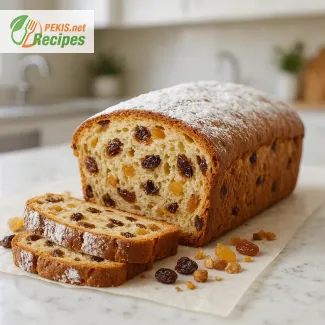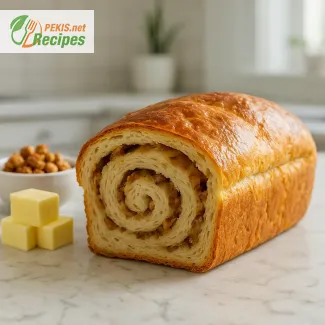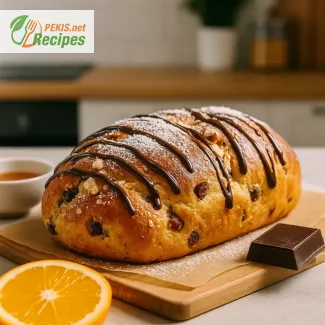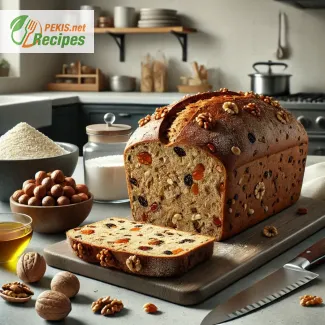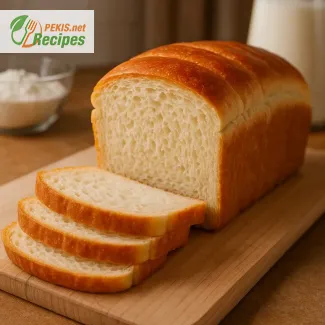
Discover the Traditional Taste of Slovenia with This Festive Sweet Braid
A cultural journey through flavor, heritage, and homemade perfection
Golden, braided, and delicately sweet – the Slovenian Pletenica is more than just bread. It's a beautifully woven tale of tradition, family gatherings, and centuries-old baking craft. This festive sweet bread holds a cherished place in the hearts and kitchens of Slovenian households, particularly during holidays, Sunday lunches, and celebratory feasts. With its rich, soft texture and subtle vanilla-lemon aroma, it captures the essence of comfort and celebration in every slice.
While many cultures have their own versions of braided bread, the Slovenian Braided Sweet Bread, or Pletenica, stands out for its unique combination of fluffiness, elegant shape, and modest sweetness. Unlike heavily frosted or overly spiced breads, Pletenica relies on high-quality, everyday ingredients and a slow rise, allowing its natural character to shine through. Whether served warm from the oven with a bit of butter or used as a showstopping centerpiece on the brunch table, it delivers a sense of home-baked luxury that's both nostalgic and universally inviting.
The symbolism and craft behind every strand
Each twist and fold in this braided bread carries meaning. In Slovenia, braiding symbolizes unity and continuity – the perfect metaphor for meals shared with loved ones. Preparing a Pletenica is a labor of love, one that involves patience, intuition, and an appreciation for texture. The dough, enriched with eggs, milk, and a touch of sugar, is kneaded to pillowy perfection and shaped with care to achieve the signature three-strand braid. When baked, it turns into a golden masterpiece with a tender interior and a lightly crisp crust.
This bread is often enjoyed during Easter, Christmas, and family milestones, yet its simplicity makes it suitable year-round. Paired with honey, jam, or simply enjoyed on its own, it fits seamlessly into both festive and everyday menus. Many Slovenians remember their grandmothers waking up early to prepare it, the scent of rising dough filling the house – a memory that makes this recipe deeply emotional and treasured.
A blend of rustic charm and culinary elegance
What makes Slovenian sweet bread so appealing is its balance between rustic and refined. While it's rooted in countryside traditions, it holds a timeless elegance that appeals to modern bakers. The use of fresh lemon zest and vanilla adds a gentle brightness, while the golden egg wash gives it a glossy, bakery-style finish. It’s no surprise that this bread often features in traditional Slovenian cookbooks and is passed down through generations like a culinary heirloom.
Even though Pletenica is deeply regional, its visual appeal and satisfying flavor have begun to capture the attention of food lovers across the globe. More and more bakers are rediscovering the charm of European sweet breads, and Pletenica is becoming a shining example of how a humble recipe can tell a powerful story. It's not just bread—it's a bridge between heritage and hospitality, an invitation to slow down and savor life.
Why you’ll love making Pletenica at home
Baking a Slovenian Pletenica at home offers more than just a delightful outcome—it’s a meditative, sensory experience. From the smooth feel of the dough beneath your hands to the irresistible aroma wafting from the oven, every moment is immersive and rewarding. Unlike more complex pastries, this bread is approachable for beginners, yet offers enough nuance to keep seasoned bakers intrigued. You don’t need any special equipment—just a few bowls, your hands, and a warm kitchen.
And when it’s done, slicing into that golden braid is pure joy. The cross-section reveals the beautiful strands within, slightly sweet and perfectly moist. It’s ideal for breakfast, afternoon tea, or even as a thoughtful homemade gift for someone special. Served slightly warm or toasted the next day, it retains its tenderness and character beautifully.
A bite of Slovenia wherever you are
You don’t have to travel to Ljubljana or the rolling hills of Prekmurje to experience this comforting classic. With this recipe, you’ll bring a piece of Slovenian heritage straight into your kitchen. It’s the perfect introduction to the country’s rich culinary tapestry, offering flavors that are both familiar and new. Whether you're exploring Eastern European baking or simply looking for a versatile sweet bread to share with family, Slovenian Braided Sweet Bread (Pletenica) is sure to become a favorite.
Let the aroma of fresh-baked tradition fill your home. Once you've tasted a slice, you’ll understand why this beautiful braid continues to hold such a beloved place at Slovenian tables – and why it deserves a place at yours, too.
- Activate the yeast: Warm the milk to lukewarm temperature (not hot). Add 1 tablespoon of the sugar and the fresh or dry yeast. Stir gently and let it sit for 10–15 minutes until foamy.
- Prepare the dough: In a large bowl, combine the flour and salt. In another bowl, beat the eggs, remaining sugar, melted butter (cooled), vanilla extract, and lemon zest. Add the activated yeast mixture.
- Knead the dough: Gradually incorporate the wet mixture into the flour and knead by hand or with a mixer using a dough hook for about 10 minutes, until the dough is smooth, elastic, and slightly sticky.
- First rise: Cover the dough with a clean kitchen towel or plastic wrap and let it rise in a warm place for 60–75 minutes, until doubled in size.
- Shape the braid: Punch down the dough and divide it into three equal parts. Roll each piece into long ropes of equal length (about 40 cm / 16 inches). Braid them together as you would braid hair. Tuck the ends slightly underneath to secure the shape.
- Second rise: Place the braid on a baking tray lined with parchment paper. Cover loosely with a cloth and let it rise for another 20–30 minutes.
- Brush and bake: Preheat your oven to 180°C (350°F). Beat one egg yolk with a teaspoon of milk and brush it over the top of the braid for a glossy finish.
- Bake: Bake for 30 minutes or until golden brown and hollow-sounding when tapped. If the top browns too quickly, cover it loosely with aluminum foil during the last 10 minutes of baking.
- Cool and serve: Let the bread cool on a wire rack. Dust with powdered sugar if desired. Slice and serve with butter, jam, or honey.
Elevating Your Pletenica: Enhancing a Classic with Modern Twists
Small changes that bring new life to Slovenian braided sweet bread
Traditional recipes are often beloved precisely because they have stood the test of time, offering comfort, nostalgia, and familiar flavors. However, there’s always room for thoughtful improvement—especially in home baking. The Slovenian Braided Sweet Bread (Pletenica), while deeply rooted in heritage, can be gently adapted to suit different preferences, dietary needs, and flavor profiles. From enriching the dough with subtle aromas to transforming the nutritional profile, there are countless ways to bring a fresh perspective to this classic.
Enriching flavor with natural additions
One of the easiest ways to elevate the Pletenica is by enhancing its aromatic depth. While lemon zest and vanilla are already part of the base recipe, you can deepen the complexity by incorporating orange zest, cardamom, or a dash of cinnamon. Orange zest gives the bread a richer, slightly tangy sweetness, perfect for festive occasions. Cardamom, often used in Scandinavian baking, lends a warm, floral spice that pairs wonderfully with the dough’s soft texture. Cinnamon offers comforting warmth and adds a seasonal charm—especially in colder months.
Another sophisticated upgrade is infusing the milk with lavender buds or chamomile flowers before adding it to the dough. These subtle flavors bring a gentle floral note, turning a simple slice into an elegant tea-time treat.
Using quality ingredients for better texture and flavor
Switching to high-quality butter and organic eggs noticeably improves the overall mouthfeel and richness of the bread. Butter with a higher fat content creates a more tender crumb, while farm-fresh eggs contribute to a vibrant golden hue and a naturally enhanced flavor. If possible, opt for stone-ground flour, which retains more nutrients and gives the dough a more robust, artisanal quality.
You might also experiment with spelt flour or a mix of white and whole wheat flour to add a nutty dimension and boost fiber. Keep in mind, however, that whole grain flours may require a bit more hydration, so adjust your liquid accordingly.
Why homemade is always better
Homemade Pletenica offers a level of customization and care that can never be matched by store-bought alternatives. Not only do you control the ingredients, but you also manage the timing, fermentation, and baking environment. This results in fresher, more flavorful bread that’s free from preservatives and additives. Furthermore, kneading the dough and shaping the braid by hand allows you to develop a deeper connection with the recipe, making it a meaningful culinary ritual.
At home, you can bake the bread exactly how you like it—perhaps slightly underbaked for a moister crumb or brushed with honey glaze for a glossier finish. These are the kinds of small decisions that elevate the final product and make it uniquely yours.
Common mistakes to avoid
Even experienced bakers can fall into common traps when making Pletenica. One of the most frequent issues is under-kneading the dough, which results in a dense, uneven crumb. Be sure to knead until the dough is elastic and smooth—it should pass the "windowpane test" where a small piece stretches thin without tearing.
Another issue is rushing the rise. The dough needs enough time to ferment and develop flavor. A warm kitchen is helpful, but avoid overheating, as this can kill the yeast. It's also important to avoid adding too much flour during kneading, which leads to a dry, heavy loaf. The dough should remain slightly sticky and soft.
During braiding, uneven strands can make the final loaf look lopsided. Measure and roll the strands carefully to ensure consistency. Lastly, brushing the bread too heavily with egg wash can cause pooling and uneven browning—apply just a thin, even coat.
Healthier alternatives and nutritional upgrades
For a healthier version of Pletenica, consider substituting some of the white flour with whole wheat, spelt, or oat flour. These alternatives add fiber and nutrients, enhancing satiety and lowering the glycemic impact. Replace white sugar with coconut sugar, maple syrup, or honey for a more complex, natural sweetness.
For a lighter version, reduce the butter slightly and add Greek yogurt for moisture and protein. You can also cut down on the sugar content by up to 20% without significantly affecting the texture or rise.
Using plant-based milk like almond or oat milk, along with a vegan butter substitute, makes the recipe suitable for dairy-free diets. And for egg replacements, try flaxseed meal, chia seeds, or even unsweetened applesauce—each adding a unique note and texture to the final loaf.
Personalizing the presentation and serving ideas
Presentation can take Pletenica from humble to extraordinary. Before baking, consider sprinkling the braid with pearl sugar, sliced almonds, or poppy seeds for a textured crust and visual appeal. After baking, a light glaze made from powdered sugar and lemon juice adds shine and flavor without overpowering the bread’s subtle taste.
You can also shape the dough into individual buns or braided rings for special occasions like brunches or weddings. These alternative shapes make serving easier and add a touch of creativity to the table.
For serving, consider pairing Pletenica with fruit compotes, herbal teas, or soft cheeses like ricotta or mascarpone. A drizzle of honey or a smear of homemade jam makes it the perfect indulgence for breakfast or dessert.
A living tradition ready for your touch
While it’s important to honor the roots of this cherished Slovenian bread, don’t be afraid to make it your own. Whether you're aiming for a healthier bake, a more fragrant twist, or just a bit of visual flair, Pletenica is an ideal canvas. Its mild flavor and versatile texture make it incredibly adaptive, allowing you to shape it into something personal and unforgettable.
With each loaf, you’re not just baking bread—you’re continuing a story. And that story can evolve beautifully, one braid at a time.
Allergens present:
- Gluten (from wheat flour)
- Eggs
- Milk (lactose)
Substitution tips:
- To make this recipe gluten-free, use a gluten-free all-purpose flour mix that includes xanthan gum.
- Replace milk with plant-based alternatives like almond milk or oat milk.
- Substitute butter with vegan margarine.
- Use egg replacer powder, applesauce (60 ml / ¼ cup per egg), or flaxseed meal (1 tbsp flaxseed + 3 tbsp water = 1 egg) to replace eggs for egg allergy.
- Vitamin A: 90 µg – supports eye and skin health
- Vitamin B2 (Riboflavin): 0.2 mg – helps energy release from food
- Vitamin B12: 0.4 µg – supports red blood cell formation
- Vitamin D: 0.6 µg – aids calcium absorption
- Iron: 1.4 mg – supports oxygen transport in blood
- Calcium: 30 mg – supports bones and teeth
- Magnesium: 18 mg – aids in muscle and nerve function
- Potassium: 80 mg – helps maintain normal blood pressure
- Flavonoids (from lemon zest): 15 mg – combat inflammation and protect cells
- Lutein (from eggs): 120 µg – supports eye health
- Vitamin E (from butter): 0.3 mg – protects cells from oxidative stress
- Selenium: 6 µg – supports the immune system and thyroid function

